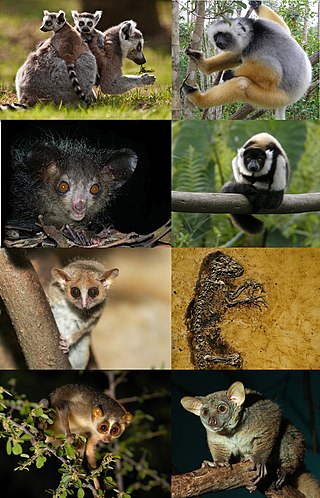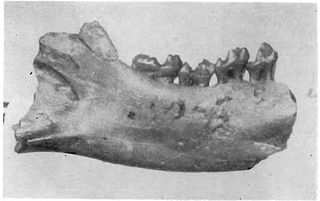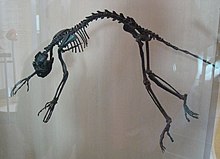
Strepsirrhini or Strepsirhini is a suborder of primates that includes the lemuriform primates, which consist of the lemurs of Madagascar, galagos ("bushbabies") and pottos from Africa, and the lorises from India and southeast Asia. Collectively they are referred to as strepsirrhines. Also belonging to the suborder are the extinct adapiform primates which thrived during the Eocene in Europe, North America, and Asia, but disappeared from most of the Northern Hemisphere as the climate cooled. Adapiforms are sometimes referred to as being "lemur-like", although the diversity of both lemurs and adapiforms does not support this comparison.

Omomyidae is a group of early primates that radiated during the Eocene epoch between about 55 to 34 million years ago (mya). Fossil omomyids are found in North America, Europe & Asia, making it one of two groups of Eocene primates with a geographic distribution spanning holarctic continents, the other being the adapids. Early representatives of the Omomyidae and Adapidae appear suddenly at the beginning of the Eocene in North America, Europe, and Asia, and are the earliest known crown primates.

Lemuriformes is the sole extant infraorder of primate that falls under the suborder Strepsirrhini. It includes the lemurs of Madagascar, as well as the galagos and lorisids of Africa and Asia, although a popular alternative taxonomy places the lorisoids in their own infraorder, Lorisiformes.

Adapiformes is a group of early primates. Adapiforms radiated throughout much of the northern continental mass, reaching as far south as northern Africa and tropical Asia. They existed from the Eocene to the Miocene epoch. Some adapiforms resembled living lemurs.

Notharctus tenebrosus was an early primate from the early Eocene, some 54–38 million years ago. Its fossil was found by Ferdinand V. Hayden in 1870 in southwestern Wyoming. When first found, Notharctus tenebrosus was thought to be a small pachyderm due to the concentration of pachyderm fossils in the area. However, after Walter W. Granger's discovery of a nearly complete skeleton, also in Wyoming, it was firmly established as a primate. Notharctus tenebrosus most resembles modern-day lemurs, although they are not directly related.

Europolemur klatti was a medium to large size adapiformes primate that lived on the continent of Europe from the middle to early Eocene. One possible relative to this species is Margarita stevensi, whose type specimen is about the size of a white-footed sportive lemur. Characteristic of most adapines are the reduced or absence of a paraconid and morphology of the paracristid. These and a few other features are synapomorphies that were used to link E. klatti with Leptadapis priscus and Microadapis sciureus, as well as Smilodectes.

Smilodectes is a genus of adapiform primate that lived in North America during the middle Eocene. It possesses a post-orbital bar and grasping thumbs and toes. Smilodectes has a small cranium size and the foramen magnum was located at the back of the skull, on the occipital bone.
Hesperolemur is a genus of adapiform primate that lived in the middle Eocene of southern California. It is an immigrant taxa which appears to be most closely related to the earlier European forms of Cantius. It was approximately 4.5 kilograms (9.9 lb) in weight and was the last surviving notharctine species, probably because of its position in the refugia that existed in southern California during the climate deterioration at the end of the middle Eocene. There are no later taxa that appear to have derived from Hesperolemur.

Altanius is a genus of extinct primates found in the early Eocene of Mongolia. Though its phylogenetic relationship is questionable, many have placed it as either a primitive omomyid or as a member of the sister group to both adapoids and omomyids. The genus is represented by one species, Altanius orlovi, estimated to weigh about 10–30 g (0.35–1.1 oz) from relatively well-known and complete dental and facial characteristics.

Pelycodus is an extinct genus of adapiform primate that lived during the early Eocene (Wasatchian) period in Europe and North America, particularly Wyoming and New Mexico. It is very closely related to Cantius and may even be its subgenus. It may also have given rise to the Middle Eocene Uintan primate Hesperolemur, although this is controversial. From mass estimates based on the first molar, the two species, P. jarrovii and P. danielsae, weighed 4.5 kg and 6.3 kg respectively and were frugivores with an arboreal, quadrupedal locomotion.
Adapis is an extinct adapiform primate from the Eocene of Europe. While this genus has traditionally contained five species, recent research has recognized at least six morphotypes that may represent distinct species. Adapis holds the title of the first Eocene primate ever discovered. In 1821, Georges Cuvier, who is considered to be the founding father of paleontology, discovered Adapis in fissure fillings outside of Paris, France. Given its timing and appearance in the fossil record, Cuvier did not recognize the primate affinities of Adapis and first described it as a small extinct pachyderm; only later in the 19th century was Adapis identified as a primate.

Europolemur is a genus of adapiform primates that lived in Europe during the middle Eocene.

Cantius is a genus of adapiform primates from the early Eocene of North America and Europe. It is extremely well represented in the fossil record in North America and has been hypothesized to be the direct ancestor of Notharctus in North America. The evolution of Cantius is characterized by a significant increase in body mass that nearly tripled in size. The earliest species were considered small-sized and weighed in around 1 kg (2.2 lb), while the later occurring species were considered medium-sized and likely weighed in around 3 kg (6.6 lb). Though significantly smaller, the fossil remains discovered of the various species of Cantius have striking similarities to that of Notharctus and Smilodectes. It is likely Cantius relied on arboreal quadrupedal locomotion, primarily running and leaping. This locomotor pattern comparable to that of extant lemurs, which has fostered the hypothesis that Cantius and other strepsirrhine adapiforms may have a close phylogenetic affinity to living lemurs.
Azibiidae is an extinct family of fossil primate from the late early or early middle Eocene from the Glib Zegdou Formation in the Gour Lazib area of Algeria. They are thought to be related to the living toothcombed primates, the lemurs and lorisoids, although paleoanthropologists such as Marc Godinot have argued that they may be early simians. It includes the genera Azibius and Algeripithecus, the latter of which was originally considered the oldest known simian, not a strepsirrhine.
Azibius is an extinct genus of fossil primate from the late early or early middle Eocene from the Glib Zegdou Formation in the Gour Lazib area of Algeria. They are thought to be related to the living toothcombed primates, the lemurs and lorisoids, although paleoanthropologists such as Marc Godinot have argued that they may be early simians. Originally described as a type of plesiadapiform, its fragmentary remains have been interpreted as a hyopsodontid, an adapid, and a macroscelidid. Less fragmentary remains discovered between 2003 and 2009 demonstrated a close relationship between Azibius and Algeripithecus, a fossil primate once thought to be the oldest known simian. Descriptions of the talus in 2011 have helped to strengthen support for the strepsirrhine status of Azibius and Algeripithecus, which would indicate that the evolutionary history of lemurs and their kin is rooted in Africa.
Djebelemur is an extinct genus of early strepsirrhine primate from the late early or early middle Eocene period from the Chambi locality in Tunisia. Although they probably lacked a toothcomb, a specialized dental structure found in living lemuriforms, they are thought to be a related stem group. The one recognized species, Djebelemur martinezi, was very small, approximately 100 g (3.5 oz).
Djebelemuridae is an extinct family of early strepsirrhine primates from Africa. It consists of five genera. The organisms in this family were exceptionally small, and were insectivores. This family dates to the early to late Eocene. Although they gave rise to the crown strepsirrhines, which includes today's lemurs and lorisoids, they lacked the toothcomb that identifies that group.
Indraloris is a fossil primate from the Miocene of India and Pakistan in the family Sivaladapidae. Two species are now recognized: I. himalayensis from Haritalyangar, India and I. kamlialensis from the Pothohar Plateau, Pakistan. Other material from the Potwar Plateau may represent an additional, unnamed species. Body mass estimates range from about 2 kg (4.4 lb) for the smaller I. kamlialensis to over 4 kg (8.8 lb) for the larger I. himalayensis.
Sivaladapis is a genus of adapiform primate that lived in Asia during the middle Miocene.
Afradapis is a genus of adapiform primate that lived during the Late Eocene. The only known species, Afradapis longicristatus, was discovered in the Birket Qarun Formation in northern Egypt in 2009. While its geographic distribution is confined to Afro-Arabia, Afradapis belongs to the predominantly European adapiform family Caenopithecinae. This taxonomic placement is supported by recent phylogenetic analyses that recover a close evolutionary relationship between Afradapis and adapiforms, including Darwinius. While adapiforms have been noted for their strepsirrhine-like morphology, no adapiform fossil possesses the unique anatomical traits to establish an ancestor-descent relationship between caenopithecids and living strepsirrhines. It ate leaves and moved around slowly like lorises.












